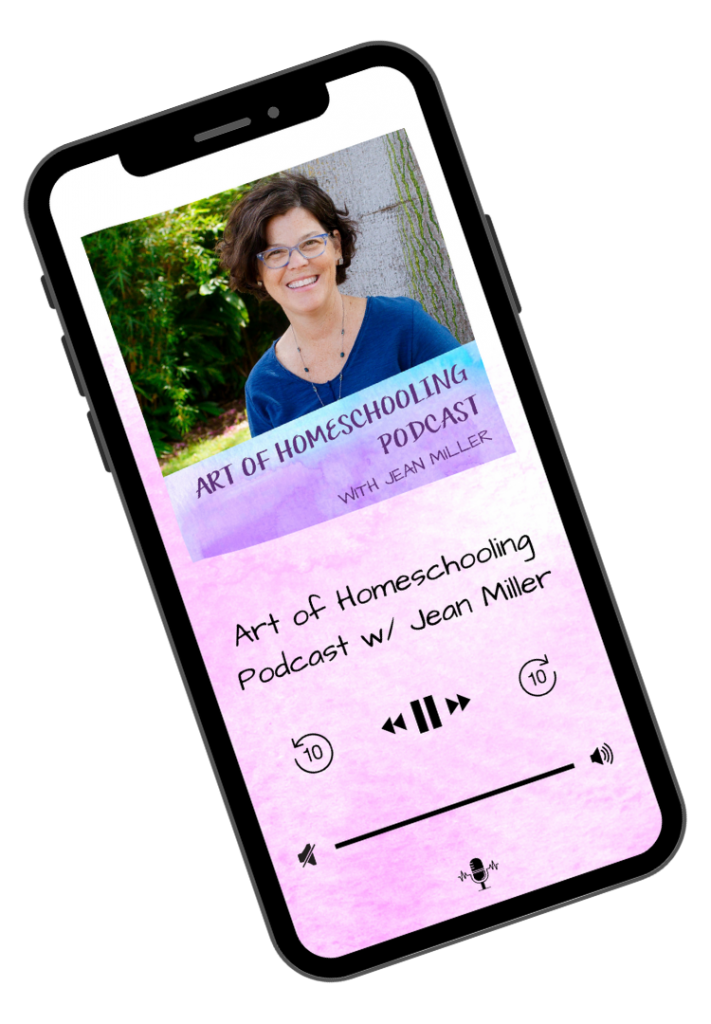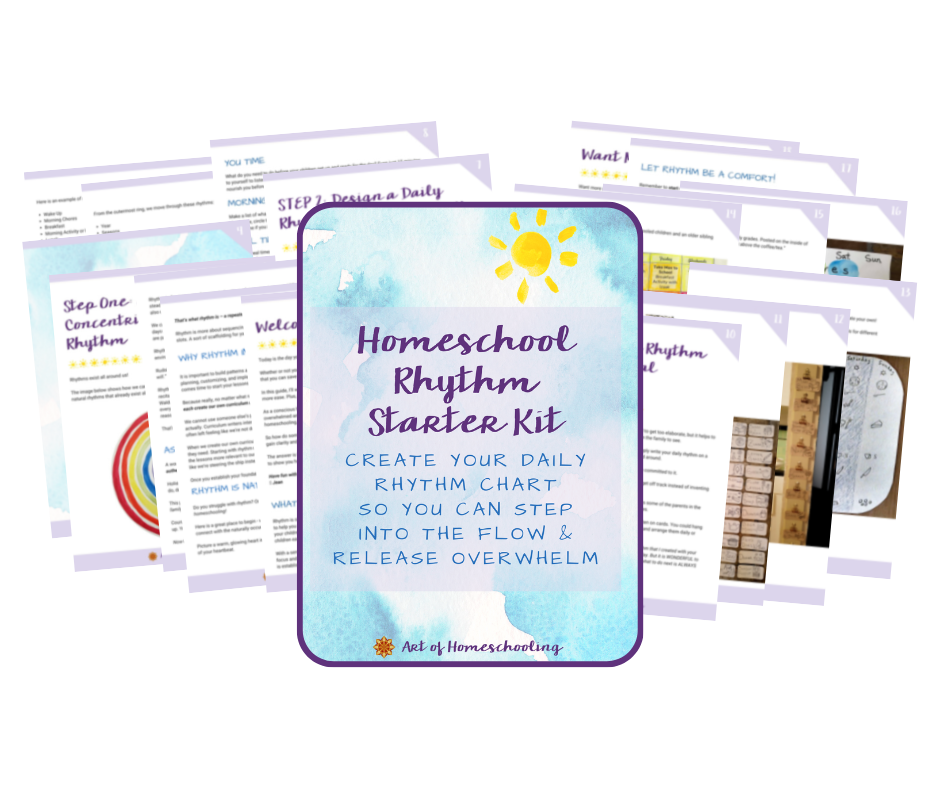Episode 114
Today on the podcast, I want to offer you a new idea to help you embrace the natural flow of the homeschooling life and seek simplicity in your daily rhythm.
Let’s talk about how to find your daily anchor points.
Scale back until it works
and then build back up from there.
I share this beloved mantra of mine with ALL of the homeschooling parents I work with as a mentor and coach. It’s so valuable to know that you can start small with tiny tweaks or baby steps. Then you can move forward, day by day, in a way that works with the natural flow and rhythms of your family.
If you’re just starting out with homeschooling, this is the key to keeping overwhelm at bay.
If you’re a newbie, please go grab my homeschool rhythm starter kit! This is a free download, so I want to make sure you have this resource to get started.
Building your daily homeschool rhythm starts with your anchor points. They provide a framework for your day and are the best place to start if you’ve scaled back for a bit.
Homeschooling provides so much flexibility to relax and flow into holidays, vacations, easy-going family days, sick days, or times when our attention needs to shift away from homeschooling.
Then, when it’s time to scale back up, we can start slow and easy with our anchor points.
So let’s get started so you can identify your own anchor points!
Find Your Daily Anchor Points
The phrase anchor points comes from the work of Kim John Payne and the Simplicity Parenting movement. These are the things that happen naturally in your day that can anchor your daily rhythm.
Children and families need the consistency and connection of anchor points through the day. Without anchor points, we can feel anxious, overwhelmed, or out of control. This is the “soul fever” that Kim refers in his book, Simplicity Parenting. (<That’s my referral link. You can read my full disclosure policy here.)
Here are four steps to guide you as you find your daily anchor points.
Step One: Make a list of 3 – 5 anchor points in your day
You can identify your anchor points as the activities that are repeated nearly every day. For many of us, these might be wake up time, 3 meals together, and bedtime. For some families, daily outside chores, a work schedule, or an outside activity might provide an anchor point as well.
So make a list of these main 3 to 5 anchor points in your days. Write them down and focus on getting solid with these for a few days, a week, or more.
Dial back your busy brain and resist the need to make this list into a To Do list. Daily rhythm is about creating a flexible, organic structure to build your family life around.
You’ll want to consider the anchor points in your days that may need a little TLC (tender loving care) and work with those especially. The goal here is to provide consistent moments of connection that your children can come to expect.
For example, after the holidays you might want to focus on cutting back sugar consumption and get back to sharing healthy meals together. Or during the summer when the days are long and hot, you might need to focus on a calm, soothing bedtime.
The rhythm of these repeated anchor points can provide predictability, a sense of safety and stability, and freedom from stress for your family with minimal effort once you get it flowing.
“When you get rhythm in a house, it’s almost like you’ve got another parent.”
~Kim john payne
Step Two: Add rituals & reminders to your anchor points
After strengthening your 3 to 5 daily anchor points, you can begin to build small reminders or rituals around these anchor points.
These could include:
- Joining hands and reciting a blessing at dinnertime
- Singing a special lullaby at bedtime
- Lighting a candle
You can begin to look for ways you want to flow into these anchor points with calm and ease. Remember, you get to choose what you want to focus on and change in your family.
Step Three: Stay consistent before building up or layering in
Next, look for consistency with your daily anchor points before going on to the next step, gradually layering in your homeschooling activities around your anchor points.
Step Four: Layer in your homeschooling activities
A good place to start layering in your homeschooling activities is with stories. Then add in verses and songs, and finally main lesson work and skills practice.
You can start small! You don’t have to try to jump into a full schedule of activities all at once. Instead, renew and strengthen your daily rhythms around your anchor points and grow from there.
Small, Doable Changes
If we want changes to have an impact, the way to go is to focus on one thing at a time. After all, we really can’t do it all, all at once.
“As parents, we often define ourselves by what we bring our attention and presence to. This is easy to forget when daily life feels more like triage. By eliminating some of the clutter in our lives, we can concentrate on what we really value, not just what we buried under,
~ kim john payne
or deluged with.”
A daily rhythm can help us eliminate the clutter and busyness so that we can focus on connection, learning, and growing together. It holds us steady without being too rigid and provides a friendly framework to help you design your homeschool days with ease and flow.
And to help you find your way back when life gets rough and rocky. Or after the chaos of holidays or vacations.
So start by choosing your anchor points and deepening those. Then build back up from there. These moments in your day anchor you into the present moment.
Rhythm helps us move through the day from one activity to the next with ease, flow, and a sense of calm.
What are the anchor points in your homeschooling day?
More to Explore
There’s so much research to back up these ideas of implementing change with a simple, slower approach. James Clear, author of Atomic Habits (<that’s my referral link; you can read my full disclosure policy here), says “Research has shown that implementation intentions do not work if you try to improve multiple habits at the same time.” You can read more in Clear’s article, The Scientific Argument for Mastering One Thing.
Top Podcasts About Homeschooling & Rhythm
Episode #3: Relax Into Your Homeschool Rhythm: Homeschooling life has a lot of moving parts! Working with your family’s daily, weekly, and yearly rhythms can help you simplify and keep things running smoothly.
Episode #13 Create a Simple Morning Routine for a Strong Start to Your Homeschooling Day: Keeping homeschooling DOABLE starts with a nourishing morning routine for YOU and unfolds from there with a strong daily rhythm for your children and family.
Rate & Review the Podcast
If the Art of Homeschooling Podcast has inspired you, I’d LOVE it if you could rate and review the podcast on your favorite podcast player! Reviews can be left on Apple Podcasts (iTunes), Podcast Addict, or Stitcher.
Or simply pop on over to lovethepodcast.com/artofhomeschooling and choose where you want to leave your review.
And if you want to show your appreciation for the Art of Homeschooling Podcast, you can buy me a coffee!
Never Miss an Episode!


Check Out All the Episodes Here



